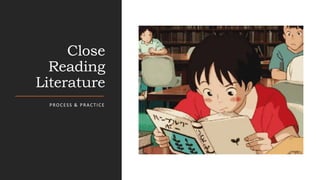
Close Reading Practices.pptx
- 2. What you “should” know by now How to analyze a work based on your emotional response How to analyze based on historical time period How to analyze based on rhetorical function How to find literary and rhetorical devices
- 3. Before We Start— Close reading responses are NOT Summaries Paraphrases Personal opinions
- 4. Step 1 Focus on the Text Focused on the variety and degree of certain literary devices, specifically metaphor, irony, tension, and paradox. Emphasized “close reading” as a way to engage with a text. Focused on form and meaning rather than an emotional reaction Emotions are extremely important, but…objective meaning more important. Objective = that which can be proved by referencing information in the text Has its limitations: lacks attention to text context, but is a place to start before using more subjective critical theories such as Feminist Theory and Deconstruction Theory which focus on context. * Subjective means based on the personal perspective or preferences of a person—the subject who’s observing something. *Objective means not influenced by or based on a personal viewpoint—based on the analysis of an object of observation only.
- 5. The Basics This presentation uses information directly from a web article titled “How to Teach Close Reading: Demystifying Literary Analysis for undergraduates” by Jarrell D. Wright, University of Pittsburgh The text boils literary analysis down into three simple steps: (0) Understanding ◦ What is happening; what does it mean (1) Noticing and ◦ How is ‘what’ shown to the reader; purposeful use of lit. devices/element (2) Explaining ◦ Why does the ‘how’ (use of lit. devices) help the reader understand the ‘what’ (support meaning)
- 6. (0) Understanding “The What” “What is happening; what does it mean” Understanding a text’s surface meaning is ‘step zero’. Summary and paraphrase inadequate substitutes for close reading, BUT… One must be able to summarize or paraphrase accurately before analyzing the work. • reading between the lines, “against the grain”, before understanding the lines themselves, “with the grain”, often leads to misinterpretations. One needs to UNDERSTAND what the text is about before deeper meaning is analyzed.
- 7. (1) Noticing “The How” “How is ‘what’ shown to the reader” “A common mistake that students make is an error of focus. Concentration on the “what” rather than the “how” and “why” First, understand than large-scale features like plot points and general character profiles (archetypes) and types. Then, examine small-scale details in a text Word choice, punctuation, use of characterization, dialogue, and figurative language A great deal of analytical work can be done with seemingly minor authorial choices, Beyond a basic understanding of the story, there is relatively little to analyze when focusing on the large-scale. Authorial choice is important It helps explain why minor details matter. All writers make carful choices that are worth examining.
- 8. (2) Explaining “The Why” “Why does the how help the reader understand the what” Explaining is moving beyond what is interesting to what is significant in the text. Use what you notice to construct an argument about how particular authorial choices affect the text. Don’t read the author’s mind about regarding choices; instead, the aim is to reveal effects of those choices. The purpose of literary analysis is to present an argument that any careful reader of the text can understand, not simply “what I think” Literary arguments should be controversial. An interpretation that is obviously true is basically a summary. Aspire to provide a reasonable thesis that readers could either agree or disagree.
- 9. Watch Out for the “Quicksand” Avoid searching for so-called “hidden meanings.” Authors usually do not plant secret “Easter eggs” into their texts Author’s make choices through attention to textual details. We are analyzing those details not deciphering a puzzle Avoid a moralistic approach of searching for “life lessons” We do this in a high school-level English class. Less appropriate for college-level work. Focus on how texts work (how it says what it says) rather than what texts teach us (only what it says) Avoid the mistake of “relating” to a text. The goal of close reading is to provide insights about the the text rather than insights about its reader. Do this by avoiding claims about what the text means “to me.”
- 10. The Kiss by Edvard Munch (1897) Apply: Step 0 “What is happening; what does it mean”, Step 1 “How is ‘what’ shown to the reader” , and Step 2 “Why does the how help the reader understand the what” by first jot down notes then discuss with partner after that, class discussion
- 11. Close Reading of a Poem FOLLOW STEP 0, 1, AND 2 BY FIRST RESPONDING IN WRITING THEN CLASS DISCUSSION
- 12. “Good Bones” Life is short, though I keep this from my children. Life is short, and I’ve shortened mine in a thousand delicious, ill-advised ways, a thousand deliciously ill-advised ways I’ll keep from my children. The world is at least fifty percent terrible, and that’s a conservative estimate, though I keep this from my children. For every bird there is a stone thrown at a bird. For every loved child, a child broken, bagged, sunk in a lake. Life is short and the world is at least half terrible, and for every kind stranger, there is one who would break you, though I keep this from my children. I am trying to sell them the world. Any decent realtor, walking you through a real shithole, chirps on about good bones: This place could be beautiful, right? You could make this place beautiful. Maggie Smith Pg. 808 Follow close reading steps Jot down notes Discuss: what is the poem about? How does it show this meaning to the reader? (focus on choices)
Editor's Notes
- Attention to large-scale features, particularly by students who are new to close reading, is likely to lead to summary and paraphrase rather than analysis.